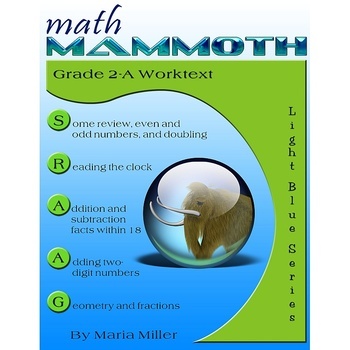Math Mammoth Grade 2-A Complete Curriculum
- Zip
Description
This product, Math Mammoth Grade 2-A, comprises a complete math curriculum for the first half of second grade mathematics studies. The curriculum meets and exceeds the Common Core standards.
The latter half of second grade is covered in Math Mammoth Grade 2-B.
This product, Math Mammoth Grade 2-A, covers fact families, even & odd numbers, doubling & halving (chapter 1), reading the clock (chapter 2), the basic addition and subtraction facts within 18 (chapter 3), regrouping in addition (chapter 4), and geometry (chapter 5). The rest of the topics are covered in Math Mammoth Grade 2-B.
Some important points to keep in mind when using the curriculum:
- The student worktext is like a “framework”, but you still have a lot of liberty in planning the studies. While addition and subtraction topics are best studied in the order they are presented, feel free to go through the sections on clock and geometry in a different order than presented in the curriculum.
- Math Mammoth is mastery-based, which means it concentrates on a few major topics at a time, in order to study them in depth. However, you can still use it in a spiral manner, if you prefer. Simply have the students study in 2-3 chapters simultaneously, such as studying both clock and addition during the same week.
- Don’t automatically assign all the exercises. Use your judgment. You can use the skipped exercises later for review.
- For review, the curriculum includes a worksheet maker (Internet access required), mixed review lessons, additional cumulative review lessons, and the word problems continually require usage of past concepts.
--------------------------------------------
The student PDF file in this product is enabled for annotation.
This means the student can fill it in using a computer or a tablet (distance learning).
The student will need to use either Adobe Reader (on desktop/laptop) or a PDF app that has annotation tools (phones or tablets). Several PDF apps with annotation capabilities exist; see more details here.
--------------------------------------------
It is recommended that you not share the entire student worktext PDF file with students. Instead, it is better to just give the students a few pages at a time. Here is a simple method for extracting a few pages from a PDF file. It is done using Google Chrome.
1. Open the PDF file in Chrome.
2. Go to "Print" (Ctrl+P).
3. Print to PDF, and choose the page range.
4. Click the "Save" button.





